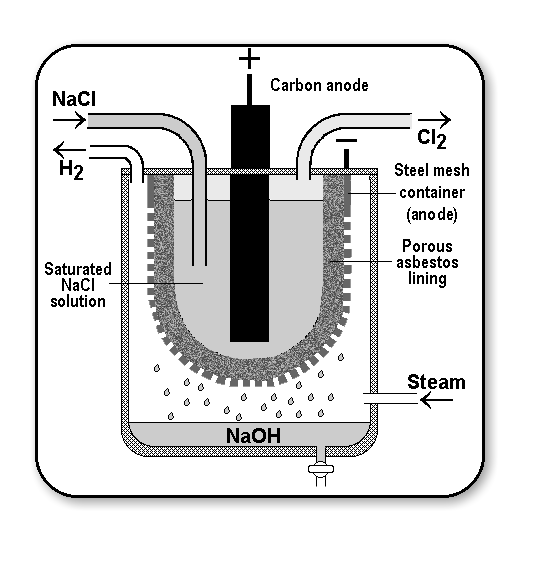
In Nelson’s cells, NaOH are formed at _____ (cathode/anode) electrode.
Answer
574.8k+ views
Hint: The device which converts electrical energy into chemical energy is known as an electrolytic cell. It consists of a positively charged anode and a negatively charged cathode. Electrical energy brings out a chemical reaction with the help of external energy sources.
Complete step by step solution:
Nelson cell is an example of an electrolytic cell where the redox reaction undergoes an application of electrical energy.
In the nelson cell, sodium hydroxide production from a brine solution is an electrolytic process.
Construction and working of Nelson cell process:
The principle of this process is a porous diaphragm. It consists of a perforated steel tube lined inside with asbestos. It is a suspended steel tank.
Cathode: the tube acts as a cathode
Anode: a graphic rod dipped in sodium chloride solution serves as an anode
Electrolyte: 10% sodium chloride solution (brine solution)

Process: due to this process is an electrolytic, electric energy should be supplied from an outer energy source. On passing electric current, chlorine is liberated at the anode and let out through the outlet. Sodium ions penetrate through the asbestos and reach the cathode when hydrogen and hydroxide ions are formed by the reduction of water. Sodium ions combine with hydroxyl ions to form NaOH which is collected in the outer tank while hydrogen is drawn off through the outlet.
Reactions at the anode: $2C{{l}^{-}}\to C{{l}_{2}}+2{{e}^{-}}$
Reactions at the cathode: $\begin{align}
& 2{{H}_{2}}O+2{{e}^{-}}\rightleftharpoons {{H}_{2}}+2O{{H}^{-}} \\
& N{{a}^{+}}+O{{H}^{-}}\rightleftharpoons NaOH \\
\end{align}$
From the above reactions, NaOH is formed at the cathode.
Note: In Nelson's cell, during the process, the steam blown keeps the electrolyte warm and helps to keep the perforation clear. The solution containing NaOH and NaCl as an impurity is taken out and evaporated to dryness. The cell gives lower quality of NaOH.
Complete step by step solution:
Nelson cell is an example of an electrolytic cell where the redox reaction undergoes an application of electrical energy.
In the nelson cell, sodium hydroxide production from a brine solution is an electrolytic process.
Construction and working of Nelson cell process:
The principle of this process is a porous diaphragm. It consists of a perforated steel tube lined inside with asbestos. It is a suspended steel tank.
Cathode: the tube acts as a cathode
Anode: a graphic rod dipped in sodium chloride solution serves as an anode
Electrolyte: 10% sodium chloride solution (brine solution)

Process: due to this process is an electrolytic, electric energy should be supplied from an outer energy source. On passing electric current, chlorine is liberated at the anode and let out through the outlet. Sodium ions penetrate through the asbestos and reach the cathode when hydrogen and hydroxide ions are formed by the reduction of water. Sodium ions combine with hydroxyl ions to form NaOH which is collected in the outer tank while hydrogen is drawn off through the outlet.
Reactions at the anode: $2C{{l}^{-}}\to C{{l}_{2}}+2{{e}^{-}}$
Reactions at the cathode: $\begin{align}
& 2{{H}_{2}}O+2{{e}^{-}}\rightleftharpoons {{H}_{2}}+2O{{H}^{-}} \\
& N{{a}^{+}}+O{{H}^{-}}\rightleftharpoons NaOH \\
\end{align}$
From the above reactions, NaOH is formed at the cathode.
Note: In Nelson's cell, during the process, the steam blown keeps the electrolyte warm and helps to keep the perforation clear. The solution containing NaOH and NaCl as an impurity is taken out and evaporated to dryness. The cell gives lower quality of NaOH.
Recently Updated Pages
A man running at a speed 5 ms is viewed in the side class 12 physics CBSE

The number of solutions in x in 02pi for which sqrt class 12 maths CBSE

State and explain Hardy Weinbergs Principle class 12 biology CBSE

Write any two methods of preparation of phenol Give class 12 chemistry CBSE

Which of the following statements is wrong a Amnion class 12 biology CBSE

Differentiate between action potential and resting class 12 biology CBSE

Trending doubts
What are the major means of transport Explain each class 12 social science CBSE

Which are the Top 10 Largest Countries of the World?

Draw a labelled sketch of the human eye class 12 physics CBSE

How much time does it take to bleed after eating p class 12 biology CBSE

Explain sex determination in humans with line diag class 12 biology CBSE

When was the first election held in India a 194748 class 12 sst CBSE




